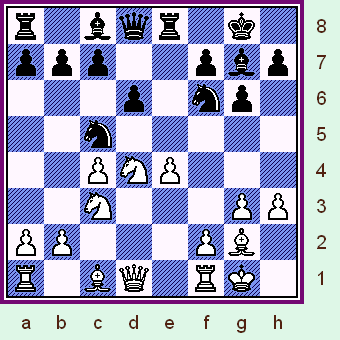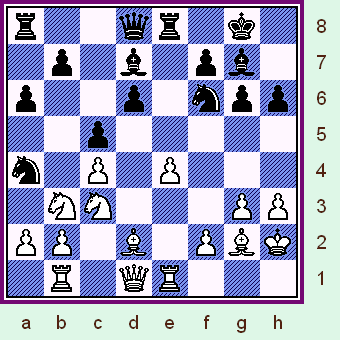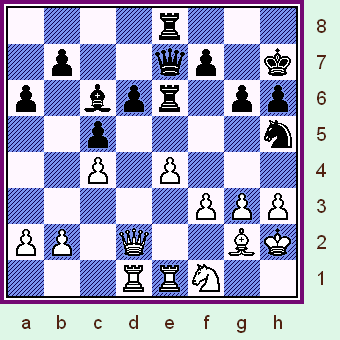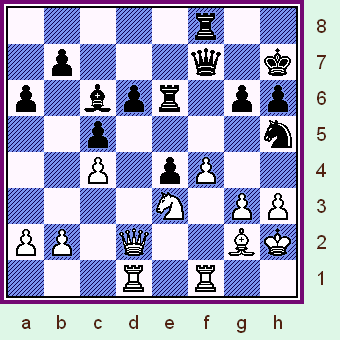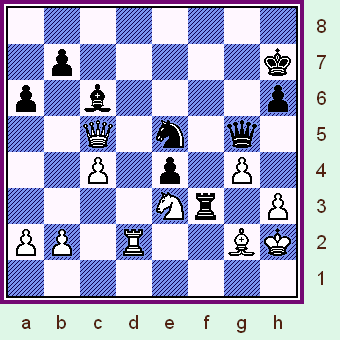GM Vladislav Tkachiev (2609) -
GM Alon Greenfeld (2549);
|
|
|
This was my pick for the "Game of The Month" for the month of May, 2005.
(I annotated several other games in the download for this particular month.)
This might not have been the most exciting game this month. It was neither the shortest nor the longest game.
It was not even the game between the two highest-rated combatants that I could find for this period.
So ...
why did I pick this one game?
*******
The answer is fairly simple.
# 1.) It IS a very interesting game of chess, it seems neither player was going to be content with a quick and easy draw here.
# 2.) It is an extremely complex game of chess, before I used the computer, I had no real clue as to exactly where the first
player might have gone astray.
# 3.) The tactics are enormous!
# 4.) It is a "King's Indian Defense," which is a soft spot for me. It is {seemingly} rare nowadays when a GM can win with
the Black pieces, it is even more enjoyable when a player manages this trick with one of my favorite openings.
The ratings are accurate, and are those of FIDE. The source for this game was TWIC, # 545.
1.d4 Nf6;
2.Nf3,
Of course there is nothing wrong with simple development here.
[ MCO - for this system - gives the following continuation:
2.c4 g6; 3.g3 Bg7;
4.Bg2 0-0; 5.Nc3 d6;
6.Nf3 Nbd7; 7.0-0 e5; {Diagram?}
reaching the same position as in the game ... just with a different order of moves.
]
Both sides continue with their respective development, note how White normally foregoes an early advance
of his KP in this variation.
2...g6;
3.c4 Bg7; 4.g3 0-0; 5.Bg2 d6;
6.0-0 Nbd7; 7.Nc3 e5; 8.e4!?,
Now White goes ahead and plays the advance of his KP ... in some lines Black might actually push his
own KP to e4.
(Basically, White does it first ... mainly to prevent Black from accomplishing this little trick.)
[ White can also play: 8.h3, here - eventually the players play this move in this game as well.
************************************************************************
White can also play:
8.Be3 c6; 9.Qd2!?,
{Diagram?}
I am not sure about this move.
( Maybe it was more sensible to play the precautionary
>/= 9.h3, "+/=" first for White. (No ...Ng4.) )
9...Ng4; 10.dxe5 Nxe3;
11.Qxe3 Nxe5; 12.Nxe5 dxe5;
13.Rfd1 Qe7; "=" {Diag?}
Black has equalized here.
M. Ignjatovic - N. Beraha;
ICT / Master's
(open) /
Dornbirn, GER; 1988.
{Black went on to win a nice game in 48 moves from here.}
]
8...exd4;
This could be nothing more than a transposition here ...
MCO gives Black playing his Pawn to the c6-square at this point.
[
The popular reference work gives {instead} the following continuation for Black:
8...c6; 9.h3 exd4;
10.Nxd4 Re8; 11.Rb1 a5;
12.Re1 Nc5; 13.b3 Nh5;
14.Be3 Qe7; 15.Qd2 Qf8;
16.Rbd1 Nf6; {Diagram?}
The end of the column here.
17.Qc2 Nfd7; 18.f4,
"+/=" {Diagram?}
White has a slight plus. (space)
GM Aleksander Wojtkiewicz - IM
Saevar Bjarnason;
ICT / New York Open /
New York City / NY / USA / 1994.
[ See MCO-14, page # 608; column # 61, and note # (b.). ] ]
9.Nxd4 Re8; 10.h3 Nc5!?;
{See the diagram given, just below here.}
Normally Black plays an early ...c6; in most lines - here Greenfeld seems to be making a conscious effort to
avoid this play, at least early on.
**********************************************
**********************************************
(r1bqr1k1/ppp2pbp/3p1np1/2n5/2PNP3/2N3PP/PP3PB1/R1BQ1RK1 w)
One of the "themes" for this particular variation of the fianchetto system of the KID, is for Black to go for play
against White's Pawn on e4.
[ The move
10...c6;
{Diagram?}
would probably transpose back to the main lines of book.
]
11.Re1 Bd7!?;
12.Kh2!?,
A slow and rather lackluster way of treating this position.
[ Or Black could try:
(>/=) 12.b4!? Ne6; 13.Be3,
"+/=" {Diag?}
when White has the tiniest of advantages here.
]
12...h6!?;
(hmmm)
Seemingly a tame move as well, normally Black does not have the time to play this - it also
{slightly} weakens Black's K-side as well.
[ After the moves:
(>/=) 12...a5!?; ('!')
13.b3 c6;
{Diagram?}
we have transposed back to the main 'book' lines of this system.
]
13.Rb1 a6;
(hmmm)
This is a radical departure from the normal way of handling these types of positions ...
most players will eventually play ...a5; in these KID fianchetto positions.
[ Black could also play:
(>/=) 13...a5; 14.b3 Qc8;
15.a3 Re5; 16.f4 Re8;
17.Rb2 c6; 18.Rf2!?, "+/="
but White maintains a small
edge. (Mostly because the first player has more
space.)
Z. Jasnikowski - A Kovalev; ICT / Master's / Polska, 1993. ]
Now f4 looks good, but for whatever reason, White systematically avoids this move, (in this game).
14.Nb3!? Na4;
15.Bd2 c5!?; {See the diagram, just below.}
Black wants to put more pressure on the White KP (on e4), but this is definitely a radical solution.
(Black's d-Pawn looks doomed, however Black keeps good play... and is never in any real trouble.)
**********************************************
**********************************************
(r2qr1k1/1p1b1pb1/p2p1npp/2p5/n1P1P3/1NN3PP/PP1B1PBK/1R1QR3 w)
This would be a good place to stop and try to evaluate the position ...
and figure out what is really happening in this struggle.
[ Maybe just 15...Rb8!?; "~" here? ]
Now White takes immediate steps to prevent from walking into a pin on the d1-a4 diagonal.
16.Qc1! Nxc3;
17.Bxc3 Qc7;
18.Nd2 Re6; 19.Qc2 Rae8;
20.f3, ('!?')
As distasteful as this might seem, White must meet the pressure on his King-Pawn with this move sooner or later.
[ After the moves:
20.a3!? Bc6; 21.b3 b5;
22.Rbd1 Qb7; 23.f3,
"+/=" {Diag?}
White is just a fuzz better due to his greater control of space and
also Black's compromised button on the d6-square.
]
Over the next few moves, both sides maneuver in an attempt to gain the upper hand. In particular, Black aims
all his forces at Tkachiev's possibly weak King-Pawn.
20...Nh5;
21.Nf1 Bxc3;
22.Qxc3 Bc6; 23.Qd2 Kh7;
24.Rbd1 Qe7!; {See the diagram, just
below.}
The most active move, continuing the plan of piling up on the e-Pawn.
**********************************************
**********************************************
(4r3/1p2qp1k/p1bpr1pp/2p4n/2P1P3/5PPP/PP1Q2BK/3RRN2 w)
Black has obvious pressure on the e-file here, what is not clear is how Black will be able to convert this
into something meaningful.
[ Fritz prefers:
>/= 24...b5!?;
{Diagram?}
and while this is not bad, the plan chosen in
the game is probably just slightly better.
]
25.Ne3 f5!;
26.Nd5 Qg7; 27.f4!?, (Probably - '?!')
This allows Black to win a Pawn. White MIGHT regain it, but never finds the time or the situation "just right" ...
to do so.
(And when White finally does regain the button, the balance of power has shifted in Black's favor.)
[ Come what may, White probably had to play:
>/= 27.g4! Nf6;
28.exf5; "~" / "+/="
{Diagram?}
as the only chance to maintain the balance or keep the position 'alive' ... in an attempt to win.
(In actuality, this continuation might only lead to a draw, but this is certainly better than losing!)
]
27...fxe4;
28.Ne3 Rf8;
29.Rf1 Qf7; {See the diagram given ...
just below.}
This move is good, but would have been even better is Black had played
29...b5!; 30.b3, b4;
and then ...Qf7; ("=/+") on the following move.
**********************************************
**********************************************
(5r2/1p3q1k/p1bpr1pp/2p4n/2P1pP2/4N1PP/PP1Q2BK/3R1R2 w)
Now White's plan becomes clear, he achieves a nice breakthrough on the King-side ...
and even will eventually regain his Pawn.
30.f5 gxf5;
31.Rxf5 Rf6;
32.Rxf6 Qxf6; 33.Ng4 Qg7!; 34.Qxd6 Nf6; 35.Ne3,
Something like this is probably forced in this position.
[ The alternative of:
(</=) 35.Nxf6+!? Qxf6; 36.Qxc5
Qf2; "~"
might allow Black too much play. ]
35...Nd7;
36.Rd2 Ne5; 37.Qxc5 Rf3!; 38.g4!?,
It is not hard to see that this loosens White's position ... at least a little bit.
[ Maybe
(>/=) 38.Ng4;
{Diagram?}
was a sturdier defense.
*******************************************************
Of course, White cannot play:
</=
38.Bxf3?? Nxf3+; 39.Kg2 Nxd2;
{Diagram?}
as Black wins back the Rook ... and remains a piece ahead.
("-/+")
]
38...Qg5;
('!') (aggressive)
{See the diagram given ... just below here.}
GM Greenfeld leaves his Rook vulnerable to capture by the WB ... and brings his Queen a little closer to the action.
**********************************************
**********************************************
(8/1p5k/p1b4p/2Q1n1q1/2P1p1P1/4Nr1P/PP1R2BK/8 w)
It is White to move here ... how does Tkachiev save his game and keep from losing here?
39.Qd6??,
(UGH!!!)
I would bet the farm that this was a mistake caused by time pressure.
(The time control was probably at move forty, I imagine. V. Tkachiev may have only had minutes - or
even seconds - to make his last few moves.)
[ There was no need to panic, White had at least a draw with the following continuation:
>/= 39.Nf5! Rxf5!?;
{Diagram?}
Black has to play this ... or at least some move that deals with all of White's threats here.
( Of course not:
</= 39...Qxd2??; 40.Qe7+, ("+/-") {Diagram?}
with mate to follow. )
40.gxf5 Nf3+;
(Probably - '!')
{Diagram?}
The most active move, the most forcing ... Black does not have enough
King safety to risk a lot and go for more here.
( Not to be recommended was:
</= 40...Qf4+?!; 41.Kh1! Qxd2;
42.Qe7+ Kg8; 43.Qxe5, "+/=" ("/\")
when a number of factors clearly favor White. (Black's more exposed King,
the lack of co-ordination of the remainder of his forces, and most importantly ...
the White Passed Pawn on the f5-square.) )
41.Bxf3 Qxd2+; 42.Bg2 Qf4+;
43.Kh1 Qc1+; 44.Kh2 Qf4+; "="
{Diag?}
with a clear draw by perpetual check, (leading to repeating the position three times). ]
39...Rxe3;
40.Qc7+ Qg7; "-/+"
White resigns, there is no real reason to continue from this position.
A grand game ... the tension of the struggle was maintained to the very end of the game.
(When I first went over this game, I thought that White was lost here no matter what ...
it turns out that I was only seeing ghosts.) My hat is off to BOTH players, this fight was
a real pleasure {and a challenge} to try to analyze!!
Copyright (c) A.J. Goldsby, 2005. All rights reserved.
***************************************************
All pages - the games and analysis - were originally
generated with the program, ChessBase
8.0.
The diagrams on this page were generated with the use of
the program, ChessCaptor
2.25.
***************************************************
